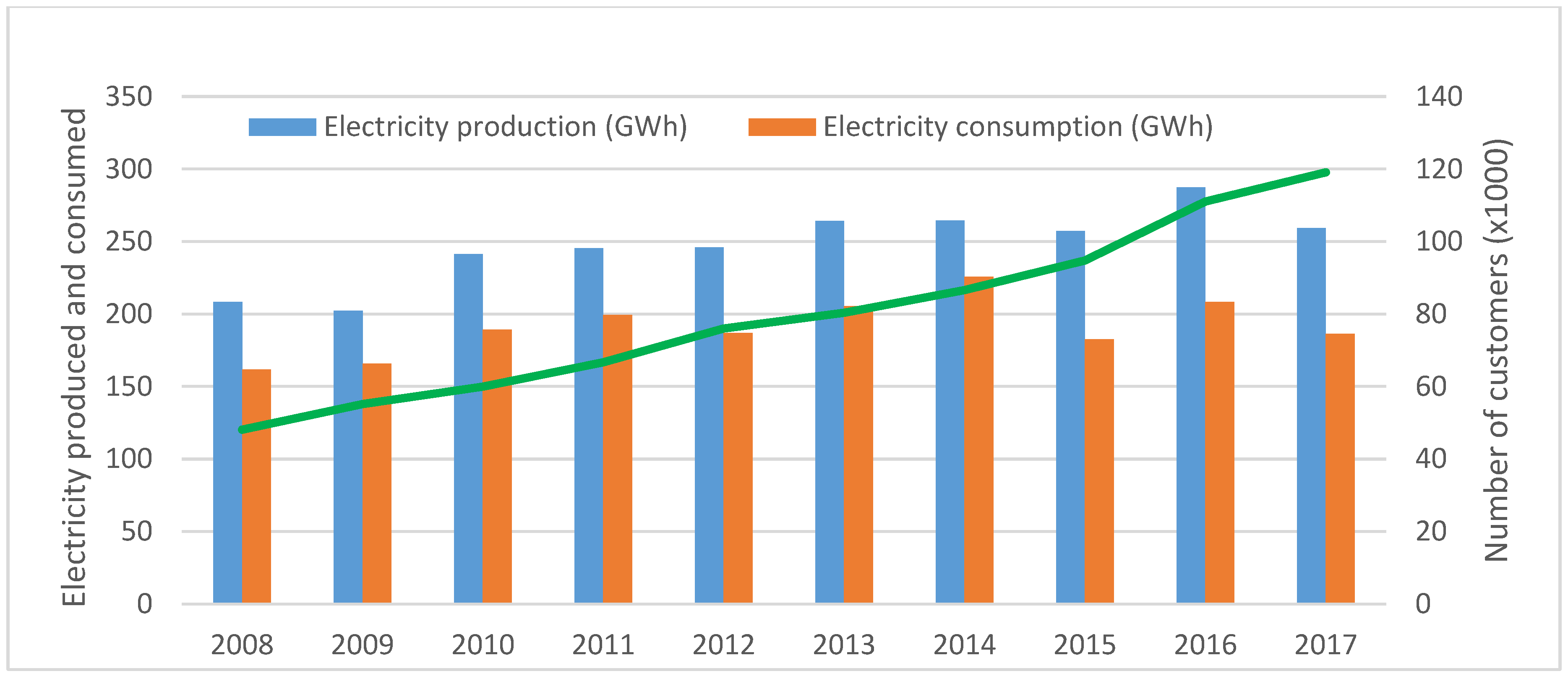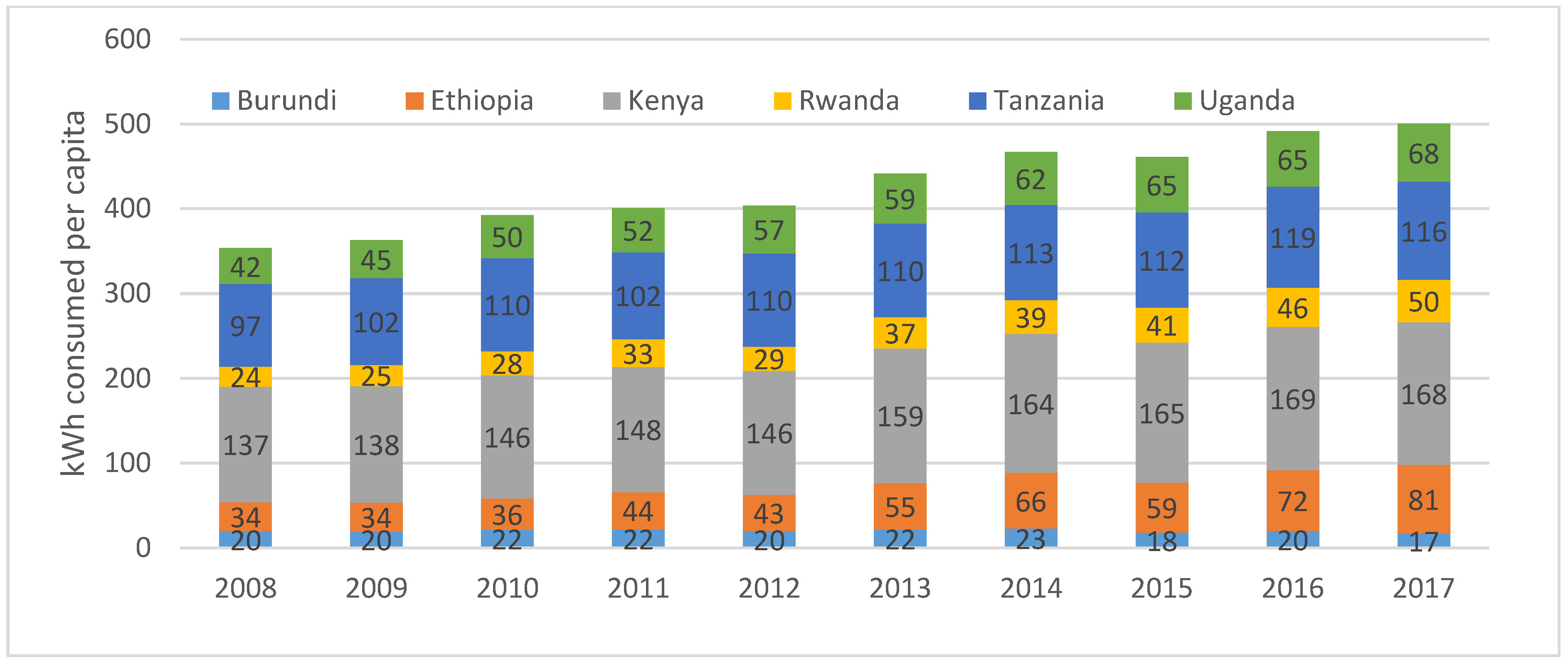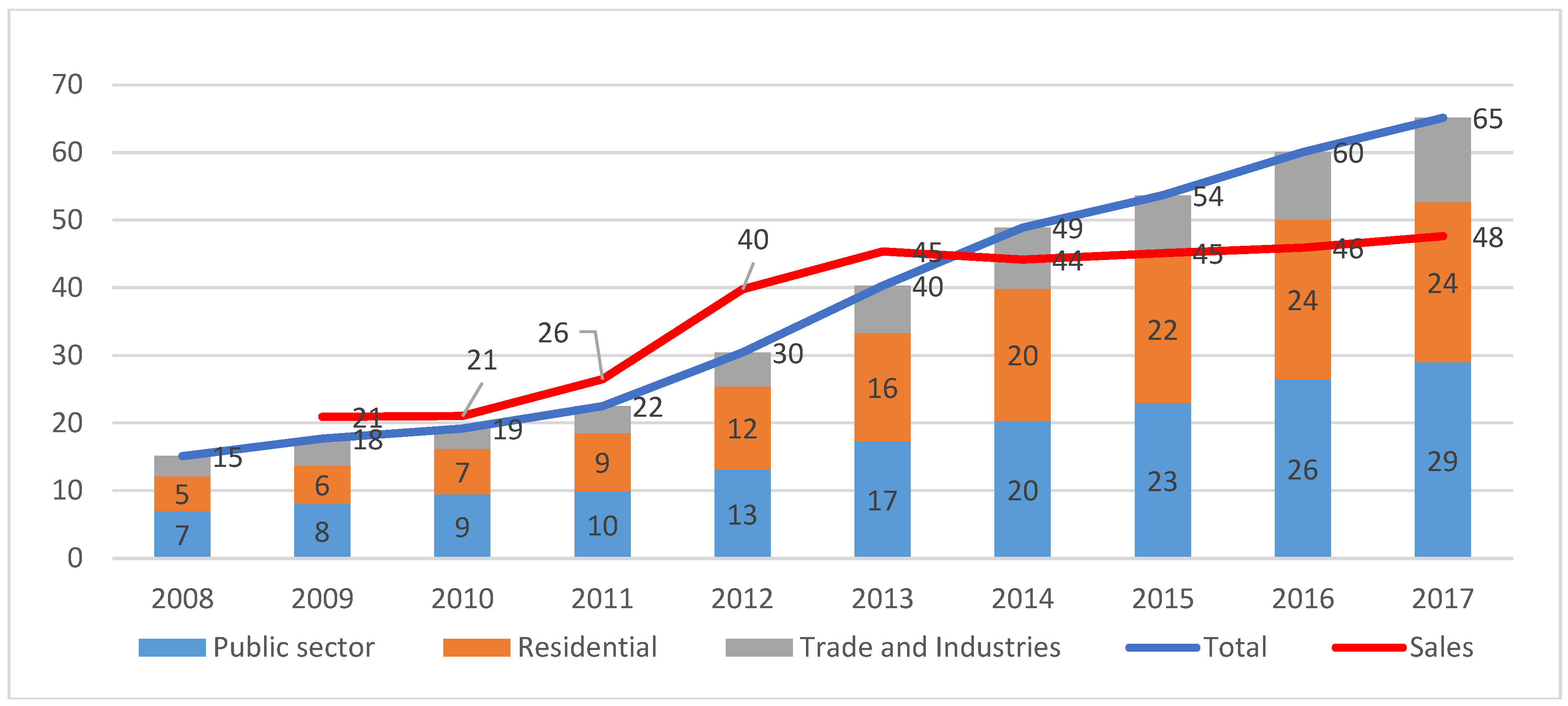Electricity Sector Organization and Performance in Burundi †
Abstract
:1. Introduction
2. Material and Method
3. Results
3.1. Electricity Sector Organization in Burundi
3.2. Status of Electricity Network
3.2.1. Electricity Generation
3.2.2. Electricity Transmission and Distribution
3.3. Performance of Electricity Sector in Burundi
3.3.1. Access to Electricity
3.3.2. Electricity Losses
4. Conclusions
Funding
Acknowledgments
Conflicts of Interest
References
- Carlsson, F.; Demeke, E.; Martinsson, P. Cost of Power Outages for Manufacturing Firms in Ethiopia: A Stated Preference Study. Energy Econ. 2018, 2473, 104753. [Google Scholar] [CrossRef]
- Das Valasai, G.; Uqaili, M.A.; Memon, H.U.R.; Samoo, S.R.; Mirjat, N.H.; Harijan, K. Overcoming electricity crisis in Pakistan: A review of sustainable electricity options. Renew. Sustain. Energy Rev. 2017, 72, 734–745. [Google Scholar] [CrossRef]
- Bongo, M.F.; Ocampo, L.A.; Magallano, Y.A.D.; Manaban, G.A.; Ramos, E.K.F. Input–output performance efficiency measurement of an electricity distribution utility using super-efficiency data envelopment analysis. Soft Comput. 2018, 22, 1–15. [Google Scholar] [CrossRef]
- Blimpo, M.; Mcrae, S.; Steinbuks, J. Electricity Access Charges and Tariff Structure in Sub-Saharan Africa; Africa Development Forum Series; The World Bank: Washington, DC, USA, 2017. [Google Scholar]
- Imam, M.I.; Jamasb, T.; Llorca, M. Sector reforms and institutional corruption: Evidence from electricity industry in Sub-Saharan Africa. Energy Policy 2019, 129, 532–545. [Google Scholar] [CrossRef]
- Ullah, K.; Arentsen, M.J.; Lovett, J.C. Institutional determinants of power sector reform in Pakistan. Energy Policy 2017, 102, 332–339. [Google Scholar] [CrossRef]
- Bamber, P.; Guinn, A.; Gereffi, G. Burundi in the Energy Global Value Chain: Skills for Private Sector Development. 2014. Available online: http://citeseerx.ist.psu.edu/viewdoc/download;jsessionid=67BBF65D6856DB9F76A550E053CFC323?doi=10.1.1.720.8019&rep=rep1&type=pdf (accessed on 18 April 2020).
- Bacon, R. Taking Stock of the Impact of Power Utility Reform in Developing Countries A Literature Review (No. 8460). World Bank Group, Energy and Extractives Global Practice. 2018. Available online: https://openknowledge.worldbank.org/handle/10986/29889 (accessed on 15 March 2020).
- Jamasb, T.; Nepal, R.; Timilsina, G.R. A Quarter Century Effort Yet to Come of Age: A Survey of Electricity Sector Reform in Developing Countries. Energy J. 2017, 38, 195–234. [Google Scholar] [CrossRef]
- Dertinger, A.; Hirth, L. Reforming the electric power industry in developing economies evidence on efficiency and electricity access outcomes. Energy Policy 2020, 139, 111348. [Google Scholar] [CrossRef]
- Nkama, H.G.; Nsabimana, R.; Ndayishimiye, L. Evaluation de l’Intégration du Burundi dans la Communauté d’Afrique de l’Est à travers le Développement des Infrastrucutres. Bujumbura. 2017. Available online: http://idec.org.bi/images/PDF/2017/mai/Evaluation_Intégration_Burundi_Communauté_Afrique_Est_travers_Développement_Infrastrucutres.pdf (accessed on 15 February 2020).
- Gratwick, K.N.; Eberhard, A. Demise of the standard model for power sector reform and the emergence of hybrid power markets. Energy Policy 2008, 36, 3948–3960. [Google Scholar] [CrossRef]
- Joskow, P.L. Electricity Sector Restructuring and Competition: Lessons Learned. Cuadernos de Economía 2003, 40, 548–558. Available online: http://web.a.ebscohost.com/ehost/pdfviewer/pdfviewer?vid=1&sid=6f22070b-e9b0-42f6-9983-3304f7b1d0ee%40sdc-v-sessmgr01 (accessed on 15 February 2020). [CrossRef]
- The World Bank. Burundi, Issues and Options in Energy Sector; The World Bank: Washington, DC, USA, 1992; Available online: http://documents.worldbank.org/curated/en/156331468770400328/pdf/multi-page.pdf (accessed on 19 April 2020).
- The World Bank. Sustainable Energy for All Technical Assistance Program (S-TAP) for Burundi Summary Report. 2019. Available online: http://documents.worldbank.org/curated/en/224921560147541144/Sustainable-Energy-for-All-Technical-Assistance-Program-S-TAP-for-Burundi-Summary-Report (accessed on 13 March 2020).
- Llorca, M.; Orea, L.; Pollitt, M.G. Efficiency and environmental factors in the US electricity transmission industry. Energy Econ. 2016, 55, 234–246. [Google Scholar] [CrossRef]
- Chakravorty, U.; Pelli, M.; Marchand, B.U. Does the quality of electricity matter? Evidence from rural India. J. Econ. Behav. Organ. 2014, 1, 1–20. [Google Scholar] [CrossRef]
- Vaninsky, A. Efficiency of electric power generation in the United States: Analysis and forecast based on data envelopment analysis. Energy Econ. 2006, 28, 326–338. [Google Scholar] [CrossRef]
- Jawad, Y.A.; Ayyash, I. Analyze the Loss of Electricity in Palestine. Case Study: Ramallah and Al-Bireh Governorate. Int. J. Energy Econ. Policy 2020, 10, 7–15. [Google Scholar] [CrossRef]
- Viegas, J.L.; Esteves, P.R.; Melício, R.; Mendes, V.M.F.; Vieira, S.M. Solutions for detection of non-technical losses in the electricity grid: A review. Renew. Sustain. Energy Rev. 2017, 80, 1256–1268. [Google Scholar] [CrossRef]
- Cambini, C.; Croce, A.; Fumagalli, E. Output-based incentive regulation in electricity distribution: Evidence from Italy. Energy Econ. 2014, 45, 205–216. [Google Scholar] [CrossRef]
- Fumagalli, E.; Schiavo LLo Delestre, F. Service Quality Regulation in Electricity Distribution and Retail; Springer: Berlin, Germany, 2007. [Google Scholar] [CrossRef]
- Smith, T.B. Electricity theft: a comparative analysis. Energy Policy 2004, 32, 2067–2076. [Google Scholar] [CrossRef]
- Tasdoven, H.; Fiedler, B.A.; Garayev, V. Improving electricity efficiency in Turkey by addressing illegal electricity consumption: A governance approach. Energy Policy 2012, 43, 226–234. [Google Scholar] [CrossRef]
- Fernandes, N. Economic Effects of Coronavirus Outbreak (COVID-19) on the World Economy. IESE Business School Working Paper No. WP-1240-E. Available online: https://ssrn.com/abstract=3557504 (accessed on 7 May 2020). [CrossRef]
- REN21. EAC Renewable Energy and Energy Efficiency, Regional Status Report. 2016. Available online: https://www.ren21.net/wp-content/uploads/2019/05/REN21-EAC-web-EN.pdf.pdf (accessed on 16 January 2020).
- Eberhard, A.; Gratwick, K.; Morella, E.; Antmann, P. Independent Power Projects in Sub-Saharan Africa: Investment trends and policy lessons. Energy Policy 2017, 108, 390–424. [Google Scholar] [CrossRef]
- Eberhard, A.; Gratwick, K.N. IPPs in Sub-Saharan Africa: Determinants of success. Energy Policy 2011. [Google Scholar] [CrossRef]




| INTERCONNECTED NETWORK | ||||
|---|---|---|---|---|
| Hydro Power Plants | Location | Owner | Commissioned Year | Installed Capacity (MW) |
| Rwegura | Gitenge | REGIDESO | 1986 | 18 |
| Mugere | Mugere | REGIDESO | 1982 | 8 |
| Ruvyironza | Ruvyironza | REGIDESO | 1980/1984 | 1.5 |
| Nyemanga | Siguvyaye | REGIDESO | 1988 | 2.8 |
| Gikonge | Mubarazi | REGIDESO | 1982 | 1 |
| Kayenzi | Kavuruga | REGIDESO | 1984 | 0.8 |
| Marangara | Ndurumu | REGIDESO | 1986 | 0.28 |
| Buhiga | Ndurumu | REGIDESO | 1984 | 0.47 |
| Nyamyotsi | REGIDESO | 0.3 | ||
| Total Hydro | 33.15 | |||
| Diesel Power Plant | ||||
| 5 MW | Bujumbura | REGIDESO | 5 | |
| 5.5 MW | Bujumbura | REGIDESO | 1996 | 5.5 |
| Location | Bujumbura | Interpetrol | 2016–2017 | 20 |
| Total0020Diesel power plants | 30.5 | |||
| Total REGIDESO (I) | 63.65 | |||
| Imports | ||||
| Ruzizi II | Rusizi | 1989 | 13 | |
| Ruzizi I | Rusizi | 1958 | 3.5 | |
| Total imports (II) | 16.5 | |||
| INTERCONNECTED NETWORK (I+II) | 80.15 | |||
| OFF-GRID NETWORK | ||||
| Kigwena | Nzibwe | ABER | 1984 | 0.062 |
| Butezi | Sanzu | ABER | 1990 | 0.25 |
| Ryarusera | Kagogo | ABER | 1984 | 0.32 |
| Nyabikere | Nyabisi | ABER | 1990 | 0.212 |
| Murore | Rusumo | ABER | 1987 | 0.024 |
| Kayongozi | Kayongozi | ABER | 2011 | 0.5 |
| Total ABER | 1.368 | |||
| Mugera | Ruvyironza | Private | 1962 | 0.03 |
| Kiremba | Buyangwe | Private | 1981 | 0.064 |
| Masango | Kitenge | Private | 1979 | 0.025 |
| Musongati | Nyamabuye | Private | 1981 | 0.006 |
| Mutumba | Kirasa | Private | 1983 | 0.045 |
| Mpinga | Mukanda | Private | 1983 | 0.016 |
| Teza | Nyabigondo | Private | 1971 | 0.36 |
| Kiganda | Mucece | Private | 1984 | 0.044 |
| Gisozi | Kayokwe | Private | 1983 | 0.015 |
| Burasira | Ruvubu | Private | 1961 | 0.025 |
| Total Private | - | - | 0.63 | |
| Total OFF-GRID | 1.998 | |||
| TOTAL INSTALLED CAPACITY | 82.148 | |||
| Plant | Fuel | Installed Capacity (MW) | Financing | Commission |
|---|---|---|---|---|
| Mpanda | Hydro | 10.4 | Burundian Government | 2021 |
| Kabu 16 | Hydro | 20 | Exim Bank of India | 2021 |
| Jiji-Mulembwe | Hydro | 49 | WB, AfDB, EU, EIB | 2024 |
| Kagu 006 | Hydro | 8 | PPP Swedenergy | 2023 |
| Solar projects | Solar | 7.5 | PPP Gigawatt Global | 2019 |
| Peat Power Project | Peat | 15 | PPP with BUCECO | 2020 |
| Ruzibazi | Hydro | 15 | Chinese Government | 2022 |
| Rusumo Falls | Hydro | 26.6 | World Bank, AfDB | 2021 |
| Ruzizi III | Hydro | 49 | WB, AfDB, EU, EIB | 2024 |
| Imports from Ethiopia | 200 | Burundian Government | 2020 | |
| Total | 400.5 | |||
| Year | 110 kV | 70 kV | 35 kV | 6.6k V–30 kV | 220 V–400 V | TOTAL |
|---|---|---|---|---|---|---|
| 1956 | 0 | 112 | 0 | 0.00 | 0.00 | 112.00 |
| 1982 | 0 | 112 | 15 | 208.20 | 206.60 | 541.80 |
| 1984 | 138 | 112 | 15 | 420.87 | 462.89 | 1148.76 |
| 1986 | 138 | 112 | 15 | 420.87 | 462.89 | 1148.76 |
| 1991 | 210 | 112 | 15 | 420.87 | 462.89 | 1220.76 |
| 2007 | 210 | 112 | 15 | 782.44 | 462.89 | 1582.33 |
| 2008 | 210 | 112 | 15 | 897.64 | 462.89 | 1697.53 |
| 2009 | 210 | 112 | 15 | 992.64 | 462.89 | 1792.53 |
| 2010 | 210 | 112 | 15 | 1331.14 | 462.89 | 2131.03 |
| 2011 | 210 | 112 | 15 | 1361.59 | 504.68 | 2203.26 |
| 2012 | 210 | 112 | 15 | 1367.13 | 526.37 | 2230.49 |
| 2013 | 210 | 112 | 15 | 1367.13 | 526.37 | 2230.49 |
| 2014 | 210 | 112 | 15 | 1367.13 | 526.37 | 2230.49 |
| 2015 | 210 | 112 | 15 | 1367.19 | 582.03 | 2286.22 |
| 2016 | 210 | 112 | 15 | 1381.75 | 593.51 | 2312.26 |
| 2017 | 210 | 112 | 15 | 1383.38 | 595.94 | 2316.32 |
| 2018 | 210 | 112 | 15 | 1396.47 | 610.19 | 2343.66 |
Publisher’s Note: MDPI stays neutral with regard to jurisdictional claims in published maps and institutional affiliations. |
© 2020 by the author. Licensee MDPI, Basel, Switzerland. This article is an open access article distributed under the terms and conditions of the Creative Commons Attribution (CC BY) license (https://creativecommons.org/licenses/by/4.0/).
Share and Cite
Nsabimana, R. Electricity Sector Organization and Performance in Burundi. Proceedings 2020, 58, 26. https://doi.org/10.3390/WEF-06938
Nsabimana R. Electricity Sector Organization and Performance in Burundi. Proceedings. 2020; 58(1):26. https://doi.org/10.3390/WEF-06938
Chicago/Turabian StyleNsabimana, René. 2020. "Electricity Sector Organization and Performance in Burundi" Proceedings 58, no. 1: 26. https://doi.org/10.3390/WEF-06938
APA StyleNsabimana, R. (2020). Electricity Sector Organization and Performance in Burundi. Proceedings, 58(1), 26. https://doi.org/10.3390/WEF-06938




